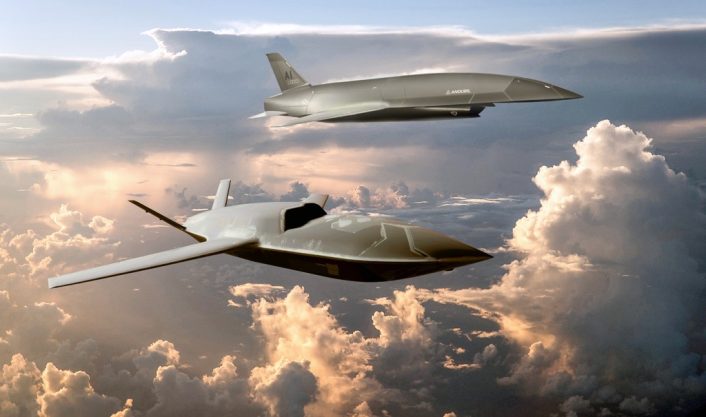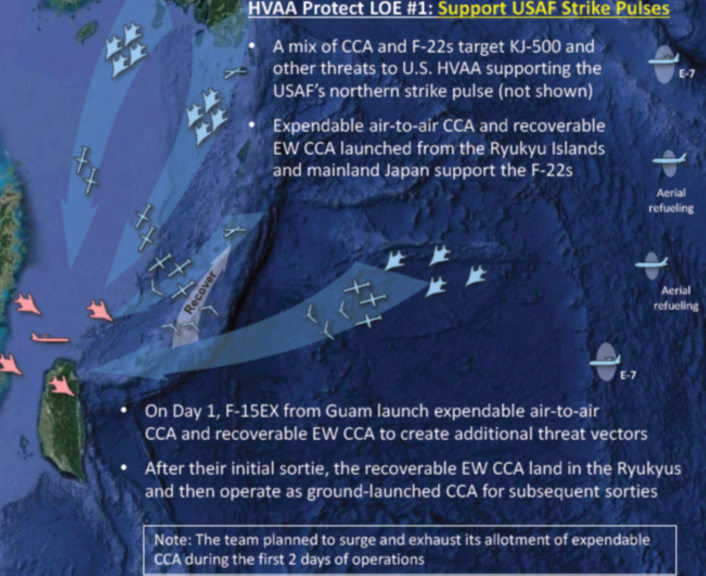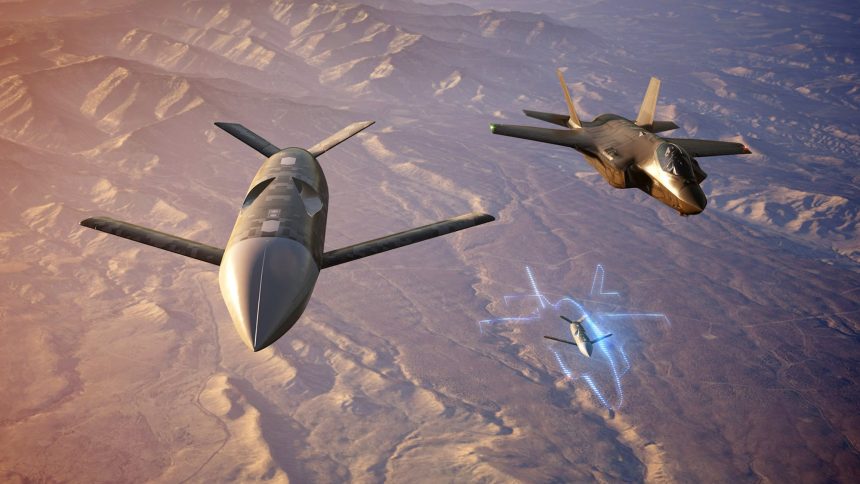CCAs would support the U.S. Air Force’s 4th and 5th gen fighters by harassing and creating targeting dilemmas for PLA forces, shaping their decisions in favor of U.S. forces.
The most concrete vision of the employment of Collaborative Combat Aircraft (CCAs) against the People’s Liberation Army (PLA) in the western Pacific emerged during a 2024 Tabletop Exercise (TTX) led by the Mitchell Institute of Aerospace Studies (MIAS), which saw the participation of three teams of the U.S. Air Force, its Air Mobility Command (AMC) and industry.
While laying out how the AI-enabled “recoverable” and “expendable” CCAs will complement the service’s diminishing fleet of Generation 4, 4.5 and 5 aircraft to confront China’s massive fleet, the study also focused on the logistics of operating CCAs while forward-basing them in the First Island Chain.
CCAs are now envisioned to add the required mass, present “targeting dilemmas;” “complicate China’s counter air operations” focusing on its Integrated Air Defense System (IADS), Surface Action Groups, KJ-500 AEW&C aircraft; “disrupt” and “impose crippling costs on its forces;” “distributed” CCA posture on the ground complicating China’s ability “to find, fix and track” the aircraft as they generate “decisive combat power” inside its A2/AD umbrella, all with aim of helping U.S. forces “drive the timing and tempo of a conflict.”
While this was the conceptual and theoretical end of the doctrine, the logistical side of CCA operations aimed at analyzing their refueling, maintenance, rearming processes, boiling down to how the CCAs are even designed. Subsequently, in a podcast hosted by MIAS’s Director of Future Concepts and Capability Assessments Mark Gunziger with representatives from Kratos, Anduril and General Atomics, the industry representatives called for rapid and immediate fielding of the CCAs, at least the Increment 1 variants, to allow units to begin experimenting and figuring out how to use them.

Diminishing USAF fleet
The service recently announced the activation of an Experimental Operations Unit (EOU) at Nellis Air Force Base, Nevada, subordinated to Eglin AFB’s 53rd Wing, to accelerate the introduction of CCAs. This followed the selection of Beale AFB, California, as the preferred location to host a CCA Aircraft Readiness Unit (ARU) and the start of the ground testing of the YFQ-42A and YFQ-44A production representative test vehicles in May 2025. The YFQ-42A is developed by General Atomics while the YFQ-44A is developed by Anduril.
The report and the TTX are explicit that these CCAs, and their future variants, are not “cheap fighters” that should neither “replace” the Air Force’s F-22s, F-35s, F-15s, F-16, F-47 NGAD penetrating counter-air aircraft (PCA), nor “constraining them as ‘loyal wingmen’. Rather, they should “complement” them for creating “unique effects in highly contested environments.”
The push for both weaponized kinetic and non-kinetic CCAs comes as the USAF faces a diminishing fleet of 4th, 4.5th and 5th generation fighters since the end of the Cold War, with no active component F-15C/Ds, and only 120 F-22 “combat-coded air superiority fighters.” These aircraft, complemented by 5th generation F-35s, cannot generate enough sorties to achieve the air superiority required to defeat China.
Another milestone down in delivering CCA to our warfighters! We activated an Experimental Operations Unit @NellisAFB to be an operational squadron. This unit is dedicated to testing and refining human-machine teaming concepts to dominate the battlespace. https://t.co/HzBjdNSXjM pic.twitter.com/6wSqNRBIiA
— General David Allvin (@OfficialCSAF) June 6, 2025
Even worse, the latest reports have said that the Pentagon rather seeks to trim the upcoming deliveries of F-35s across the services. The U.S. Air Force will receive 24 F-35As, rather than the 48 provisionally approved by Congress last year. The U.S. Navy’s F-35C deliveries will be cut from 17 to 12, and the U.S. Marine Corps will lose two jets. The future of the E-7A Wedgetail AEW&C aircraft, meant to replace the ageing E-3 Sentry AWACS, is also under doubt in the 2026 budget.
How to Fight the PLA with the CCAs
The report quoted chief of the Air Combat Command General Kenneth Wilsbach, who said how the CCAs should “pose a diverse threat that is more difficult for adversaries to accurately characterize and counter in highly dynamic, time-compressed environments.” This “uncertainty” could be exploited “to disrupt an adversary’s counterair operations and react in ways that increase the survivability and lethality of all U.S. forces.”
CCAs forward based “closer to the fight” in southern Japan and Philippines in the First Island Chain and those launched from the air, closest to the Taiwan Strait, can help the Air Force “generate counter air sorties […] despite the increased threat of PLA missile attacks,” which the TTX teams accepted, since the CCAs have smaller ground logistics footprints. “This close-in CCA force posture would enable […] U.S. forces drive the timing and tempo of a conflict with the PLA and reduce the need to aerial refuel recoverable CCA.”
US Air Force readies to award collaborative combat aircraft deals.
Air Force plans to field several different types of CCAs, with different capabilities & levels of survivability, to carry out a wide range of missions including strikes, surveillance, jamming,& serving as decoys pic.twitter.com/e95vvKj44s
— Varun Karthikeyan (@Varun55484761) February 15, 2024
Specifically, the Air Force’s Generation 4 fighters and the CCAs can “maintain pressure on the PLA’s air defenses […] with no reprieve […] while the Air Force regenerates its strike forces.” A tactical picture involves inducing the PLA to launch its fighters, “keep its KJ-500s airborne” and engage its SAGs in ways that will reduce the PLA’s ability to regenerate its forces to surge against U.S. strikes. Also, CCA “waves” and Gen 4 jets with long-range air-to-air missiles can “pressure” China’s IADS, “both during and between U.S. strikes.”
This will also require developing non-kinetic Electronic Warfare (EW)-capable CCAs with the maximum commonality of parts with the weaponized ones, themselves capable of operating “available” munitions for easier supply chains and “logistics sustainment requirements.”
Concept missions
The three TTX planning teams independently selected forces for their missions using inventories of Air Force fighters, bombers, electronic attack aircraft, and eleven notional CCA designs, labelled as CCA-1 to CCA-11. CCA-1 to CCA-6 were counterair drones and, except for CCA-5 which was “expendable,” the others were of the “recoverable” types, with all being in the $2 million to $ 40 million price range. CCA-7, CCA-8 and CCA-9 were “strike” aircraft, with CCA-7 being recoverable, while the last two are expendable loitering PGM types. CCA-10, meanwhile, is a recoverable ISR aircraft, while CCA-11 is an expendable drone for electronic attack roles.

The MIAS report showed graphic renditions of “CCA Sweep Operations”; protecting “High-Value Airborne Assets (HVAA)” like aerial refueling tankers, E-7A Wedgetail, and conducting SEAD using both kinetic and non-kinetic (EW) to “disrupt, degrade, and destroy PLA SAG air defenses and coastal SAMs screening access to the Taiwan Strait.” All these were ahead of larger “Air Force Maritime Strike Pulses.” That larger operation showed a notional, yet telling, rendition of a 48 aircraft complement of B-21 Raiders, B-2 Spirits, F-35As and F-15EXs, each heading towards Taiwan’s northern and southern axes.
The “CCA sweep” operations had attritable CCAs to probe PLA defenses; counterair loyal wingmen with air-to-air weapons; EW CCAs, ISR CCAs working with F-22s, F-35s, F-15EX and F-16s to “stimulate PLA defenses” and attack its KJ-500 AEW&C from various axes. The “HVAA protect” missions meanwhile shows mostly EW and ISR CCAs launching and recovering interchangeably from Guam and Japan’s Ryukyus, working with F-15EXs and F-22s to create “additional threat vectors” and maintain pressure on the PLA’s defenses. HVAAs would launch several times a day during strike pulses and “set the conditions between maritime strike pulses and prevent KJ-500sfrom choosing when to launch against Air Force HVAA.”
THE FUTURE OF AERIAL COMBAT IS HERE!
The @usairforce has officially kicked off ground testing for the Collaborative Combat Aircraft program. pic.twitter.com/HMO4TGoMEq
— Department of Defense 🇺🇸 (@DeptofDefense) May 3, 2025
Aircraft central to the SEAD missions would be CCA-8, CCA-9, CCA-10, CCA-11, the EA-37B Compass Call and the RC-135 Rivet Joint. These would maintain persistent ISR coverage over the SEAD team’s assigned area, provoke the PLA SAG’s Emissions Control (EMCON) and jam them and other Chinese IADS. Meanwhile, a new CCA-12, derived from the CCA-8, would be a loitering munition acting as the decoy to force Chinese warship radars to track and engage them. All these operations are split between four phases of the first seven opening days of a Taiwan contingency.
CCA Basing and Logistics
The TTX teams recommend that basing distributed CCAs in the First and Second Island Chains need to be supported by adequate personnel, fuel and food, which would be achieved only by a diplomatic effort to wrap the basing agreements in these countries, especially in Japan and the Philippines. Sourcing fuel and food locally from the host countries would follow to support CCA forces.
CCA numbers emerged as another factor, with the teams assuming the presence of thousands of airframes of some of the CCAs. In the podcast with Col. Robert “Otis” Winkler, USAF (Ret), Vice President at Kratos Defense; Anduril’s director of Air Dominance Systems Andrew “Scar” Van Timmeren; and Scott “Fug” Gilloon, the sector vice president of Air Force Strategic Development and Capability Assessments at General Atomics, it was stressed how ordering large numbers of CCAs now itself and getting them out into the field allow refining many of these and identifying early on.









